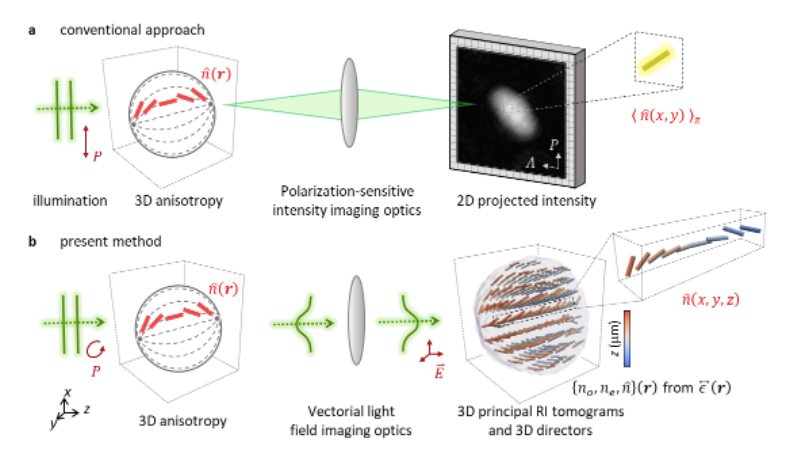Prof. YongKeun Park’s group at KAIST has developed a label-free tomographic method for measuring three-dimensional (3D) dielectric tensors of the type not directly measured thus far. The study was published in the March 3 issue of Nature Materials (Shin, S. et al. Tomographic measurement of dielectric tensors at optical frequency. Nat. Mater. 21, 317–324 (2022)).
The dielectric tensor characterizes light-matter interaction in consideration of the polarization of light, optical anisotropy, and molecular orientation. Owing to its importance in various scientific and industrial applications, the lack of an imaging modality for direct measurements of 3D dielectric tensors has been one of the fundamental limitations in photonics. Existing methods only indirectly access information pertaining to 3D dielectric tensors, though this is limited to two-dimensional, qualitative, and strict sample conditions or assumptions.
The research team has developed a label-free tomographic method that can reconstruct 3D dielectric tensors. A polarized plane wave is illuminated onto an optically anisotropic structure with various incident angles and circularly polarization states. Then, the scattered fields are measured using an interferometer and converted into vectorial diffracted field components. Finally, by inversely solving a vectorial wave equation, the 3D dielectric tensor is reconstructed.
The technical challenge was that this inverse problem was underdetermined; the number of unknowns is greater than that of measurements in the conventional approach. To overcome this limitation, the proposed method utilized additional holographic images measured with slightly tilted incident angles. The slightly tilted illumination offers an additional orthogonal polarization, changing the underdetermined problem into a determined problem. Although scattered fields rely on the illumination angle, the Fourier differentiation theorem allows the extraction of the same dielectric tensor for the slightly tilted illumination.
The research team demonstrated their method by reconstructing well-known liquid crystal (LC) structures, including those with the twisted nematic, hybrid aligned nematic, radial, and bipolar configurations. Furthermore, the non-equilibrium dynamics of annihilating, nucleating, and merging LC droplets, and a LC polymer network with repeating 3D topological defects were directly measured. “This is the first experimental results of non-equilibrium dynamics and 3D topological defects in LC structures. The proposed method allows us to explore inaccessible nematic structures and interactions in non-equilibrium dynamics,” first author Dr. Shin says.
This research was possible due to the manufacturing technology of various LC structures by teams at the Ulsan National Institute of Science and Technology (UNIST) Physics Department headed by Professor Jun-Woo Jeong, the KAIST Department of Biochemical Engineering headed by Professor Kim Shin-Hyun, and the KAIST Chemistry Department headed by Professor Dong-Ki Yun. This work was supported, in part, by the National Research Foundation of Korea and by a grant from the KAIST ITVC, Industry Liaison Center (G-CORE Project) funded by the Ministry of Science and ICT.

Dr. Seungwoo Shin, Prof. YongKeun Park Dept. of Physics, KAIST
Homepage: https://bmol.kaist.ac.kr
E-mail: yk.park@kaist.ac.kr






